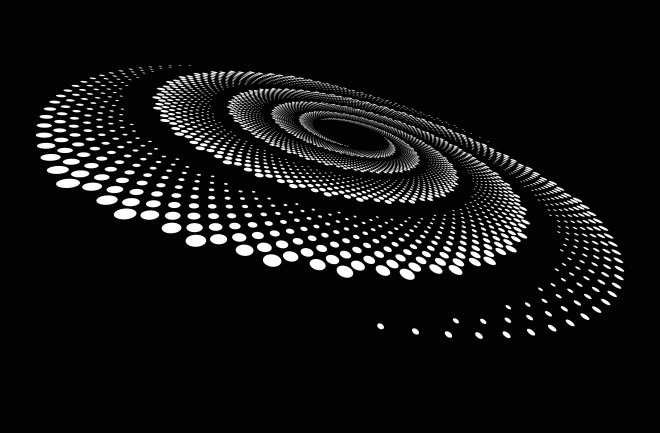When astronomers study the rotation of distant galaxies, they immediately come up against a puzzle. The stars are held together by gravity, which prevents them being slung into intergalactic space as the galaxies rotate. Indeed, astronomers can calculate the amount of gravity based on the mass of the stars they can see.
The puzzle is that the outermost parts of these galaxies are moving too quickly. There does not seem to be enough of this mass to stop these stars from flying away.
The fact that this does not happen is one of the great mysteries of modern cosmology. Some force must be holding galaxies together but astronomers do not know where it comes from.
Their best guess is that galaxies must be filled with matter they cannot see that exerts a gravitational force on the stuff they can see. And the search for this so-called dark matter is one of the great endeavors of modern science. But despite years of research and experiments costing billions of dollars, nobody has directly observed dark matter.
Cosmic Puzzle
But there is another explanation. Back in the 1980s, a physicist called Mordehai Milgrom suggested that on a galactic scale, Newton’s laws of motion might be subtly different to those observed on Earth. And that these Modified Newtonian Dynamics or MOND could provide the extra gravitational oomph to hold galaxies together instead of dark matter.
But as with dark matter, little evidence has emerged to support this idea. Various studies have looked at the way MOND might influence the orbits of distant objects, like Pluto or indeed, the Pioneer and Voyager spacecraft, but without encouraging results. And many astronomers dislike the idea because it is an essentially arbitrary change to Newtonian dynamics.
For this reason, as the controversy over Modified Newtonian Dynamics-versus-dark matter has ebbed and flowed, astronomers have tended to favor the dark matter idea.
But that may now change thanks to the work of Jonathan Oppenheim and Andrea Russo at University College London who have worked out why Milgrom’s MOND idea might be true after all. This gives MOND a theoretical foundation that will increase its attractiveness to astronomers and physicists.
The new work is based on an idea that Oppenheim put forward several years ago to reconcile the incompatibility between two of the great foundations of modern physics: quantum mechanics and general relativity.
Quantum mechanics governs the behavior of the universe on the smallest scales, while relativity operates at the largest scales. But the character of these theories is utterly opposite, with quantum mechanics suggesting the universe is probabilistic in nature while relativity implying it is entirely classical.
This poses a dilemma when it comes to deriving a theory of quantum gravity, one that physicists have yet to solve.
Oppenheim’s idea is that relativity is classical but fundamentally stochastic, by which he means that it has a random character, rather like Brownian motion, the random motion of particle suspended in a fluid. This allows quantum mechanics and relativity to be combined in a way that is mathematically compatible.
One consequence of the new approach is that at the human scale, gravity is entirely Newtonian, just as physicists observe. But another is that at galactic scales, the acceleration due to gravity can vary by a small but random amount, as if spacetime were eliciting some kind of Brownian motion on the masses within it. It is this stochastic nature of spacetime that generates the extra gravitational force that holds galaxies together.
“We show that this stochastic behavior leads to a modification of general relativity at low accelerations,” they say. “In the low acceleration regime, the variance in the acceleration produced by the gravitational field…acts as an entropic force, causing a deviation from Einstein’s theory of general relativity.”
May The Force
In other words, the entropic force acts as if it were additional matter. “The entropic force driven by a stochastic cosmological constant can explain galactic rotation curves without needing to evoke dark matter,” they conclude.
The similarity with Milgrom’s idea is not lost on Oppenheim and Russo. Indeed, they show their idea produces similar predictions to Milgrom’s. And rather than being an arbitrary modification to Newtonian dynamics, the new theory is a necessary consequence of combining relativity and quantum mechanics into a single framework.
That’s interesting work with significant potential for future experiments that will test the nature of Newtonian dynamics.
But Oppenheim and Russo urge caution. They point out there are other reasons beyond galactic rotation to suggest that dark matter exists. For example, the gravitational mass of distant galaxies acts like a lens by bending light as it passes by. And the size of this bending suggests that dark matter must contribute to this mass.
Oppenheim and Russo’s say that before their idea can gain traction, it needs to be studied further, particularly by simulating the Brownian motion of spacetime and its effects on mass.
That will provide some happy hours of work for astronomers. It may prove less happy for the experimentalists who have spent billions searching for evidence of dark matter here on Earth.
Ref: Anomalous Contribution To Galactic Rotation Curves Due To Stochastic Spacetime: arxiv.org/abs/2402.19459

